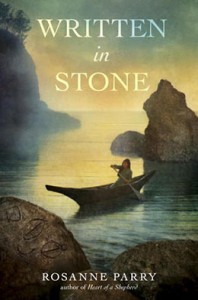In her review of Written in Stone Debbie Reese took issue with the work of Chief Lelooska. To be clear, Lelooska is not in the story and is mentioned only briefly in the author’s note. Lelooska himself died in the late 1990s and his work is carried on by the Lelooska Foundation. Here is a link to more information about him and the Lelooska Foundation, for those who maybe following the conversation and be unfamiliar with the work of this author, illustrator, carver, linguist and historian. And here is a picture of Chief Lelooska in his traditional regalia.
I’m well aware, as Debbie has mentioned, that Lelooska was adopted into one of the bands of the Kwakwaka’wakw (also known as the Kwakiutl) tribe of British Columbia. Not everyone enjoys his art and not everyone likes the living history programs that he has provided in Washington for almost 40 years. I’m not interested in changing Debbie’s mind on this point. However hers is not the only opinion on the topic. Native Americans are not monolithic in their views and some of them are very much in favor of sharing their traditional arts with the wider community.
Among the tribes of the Pacific northwest, the right to tell a traditional story with its accompanying song, dance, and regalia is conferred in a potlatch. Lelooska’s right to share the stories he does was given to him by Chief James Aul Sewide and witnessed and agreed to by all the tribal members and neighboring tribes present at the potlatch. If they did not wish for Don Smith to become Chief Lelooska they could have chosen not to come to the potlatch. But they came, which is all the evidence I need to determine that he is doing this work fairly and in keeping with the traditions of the Kwakwaka’wakw. The tribe had the opportunity to deny the Lelooska Foundation the right to perform their living history programs after Lelooska died. But they came to the potlatch for his brother Tsungani and again conferred on him the ownership of the stories his family continues to present to the public.
I received an email just last week from the head of the planning team who was hired by the Quinault to relocate the village of Taholah out of the tsunami inundation zone. My book was recommended to him by somebody from the tribe as a vehicle for understanding them better. He’s aware of the weight of this project, to move a village site more than a thousand years old. He and his team want to make sure that what they design really serves the tribe well. Simply sticking in some local art at the end of the process isn’t what they want. They want to really think through with the community what their village needs in order to be a home to them. And so the book is a vehicle for thinking and talking about what the land and ocean and river and lake means to the community. Not because it’s a perfect representation of Quinault and Makah culture, they already have non-fiction materials aplenty for that purpose. It does what fiction does best, it invites reflection and conversation.
The bottom line for me is that each tribe gets to decide for themselves what is an acceptable representation of their culture. One of the reasons I chose the Quinault and Makah rather than one of the many smaller tribes in the area, is that they are well-accustomed to speaking up for themselves at a national and international level. If something about my book bothers them, I’m confident they will say so publicly. So far they’ve had no criticism of the book. The community in Taholah has invited me to come and celebrate it with them later this spring. The curator of their historical collection recommends the book to people who are interested in learning more about that tribe. That is all the endorsement I need.

 not mine is wrong. Making things up is what a fiction writer does. When the cover team was meeting I sent them a bunch of photographs of the Olympic Peninsula so they could get a feel for the ecosystem. The pictures included one of a petroglyph which is on public land and which commonly appears in works of non-fiction. I was so happy to see Richard Tuschman, the cover artist, incorporate a few petroglyphs on the cover–inventing an element in the style of this art but not stealing what’s not his to copy.
not mine is wrong. Making things up is what a fiction writer does. When the cover team was meeting I sent them a bunch of photographs of the Olympic Peninsula so they could get a feel for the ecosystem. The pictures included one of a petroglyph which is on public land and which commonly appears in works of non-fiction. I was so happy to see Richard Tuschman, the cover artist, incorporate a few petroglyphs on the cover–inventing an element in the style of this art but not stealing what’s not his to copy.



